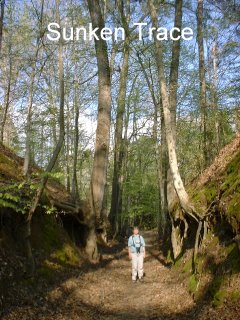Thursday, September 16, 2010
Natchez Trace, MS - April 2
 After leaving Rainbow's End, we headed east, stopping 3 nights at Martin Dies Jr SP near Jasper, TX. We hiked in the park and also revisited Big Thicket National Preserve, the island of biodiversity that used to cover southeast Texas. We went to the Pitcher Plant trail and were lucky enough to see the pitcher plants just starting to bloom. We also hiked on a nature trail called the Dogwood Trail, which was an area set aside by the Louisiana Pacific Corp for people to enjoy -- sort of a defense against the "tree-hugger" propaganda. We saw two more new birds here, the Louisiana Waterthrush and the Northern Parula.
After leaving Rainbow's End, we headed east, stopping 3 nights at Martin Dies Jr SP near Jasper, TX. We hiked in the park and also revisited Big Thicket National Preserve, the island of biodiversity that used to cover southeast Texas. We went to the Pitcher Plant trail and were lucky enough to see the pitcher plants just starting to bloom. We also hiked on a nature trail called the Dogwood Trail, which was an area set aside by the Louisiana Pacific Corp for people to enjoy -- sort of a defense against the "tree-hugger" propaganda. We saw two more new birds here, the Louisiana Waterthrush and the Northern Parula.Our next stop was Lake Kincaid, about 20 miles west of Alexandria, LA. While there we had a very nice visit with Willie's cousin Joe and his wife Marilyn. Willie hadn't seen them in over 20 years, which means that Doug had never met them. We hiked, saw the sights in town, ate wonderful food (including the best chocolate pie ever), and watched lots of basketball (March Madness). It was a very successful "reunion" and will surely be repeated when opportunity arises.
We continued east to Natchez, MS, where we spent 4 nights and did much sightseeing. Natchez is a city steeped in history and one which was spared a lot of destruction during the civil war. So there are abundant antebellum homes. We walked for hours around the historic districts of the downtown area enjoying the architecture and the lovely gardens. The next day we went on a 4-mansion tour as part of their Spring Pilgrimage. We saw an octagonal house called Longwood, which was started in 1860 and never finished because of the war. The family lived in what is called the "basement" but is really a quite nice first floor by most standards. We also saw Linden, which is currently a bed & breakfast, and Elms Court and Arlington, which are privately owned and not usually open to the public. In the evening we went to a performance of "A Southern Road to Freedom", the Natchez saga of African-Americans from slavery to modern times presented by the Southern Road to Freedom Gospel Choir. During our final day there, we visited Melrose plantation, which is owned by the Natl Park Service, and walked around the grounds. We also went to Grand Village of the Natchez Indians, an early ceremonial mound center and chief settlement of the Natchez Indians. After the tribe attacked a French fort in 1729, the French retaliated and destroyed the village. All that is left is the mounds and a museum full of artifacts that were found on the site.
We then started up the Natchez Trace Parkway, stopping at Rocky Springs, one of the free campgrounds along the Trace. We managed to get a lovely spot and settled in to see how many days we could go with no hookups. The first day we went to the historic town of Port Gibson and picked up some tourist info and looked around a bit. We continued over to Grand Gulf Military Park, the site of a battle between Union gunboats and the Confederate forts at Grand Gulf. The actual city of Grand Gulf is basically a ghost town. We came back to Port Gibson the next day to walk around and look at the historic homes. We also went to the Heritage Festival there and attended a quilt show at the Mississippi Cultural Crossroads. In addition to the many lovely quilts on display, there was a panel exhibit which showed an overview of quilting by African-Americans throughout the state going back as far as five generations.